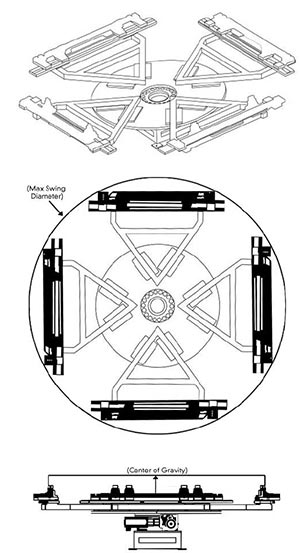Sizing an index drive can be extremely complicated, but as long as the correct steps are taken the correct model can be chosen.
 In sizing a rotary index table, most customers have a design of tooling established as a 3d model in a design software. It is possible to have the software provide the inertia in the mass properties. But it is up to the designer to make sure the output is correct and in MOST instances, the designer has no experience with this to know what is correct or not. It is imperative that the software is told to select ONLY the rotating components on the index drive and also to ensure the components chosen have the correct density and properties applied to them. For example, setting the density of a dial plate as steel instead of aluminum in the software can make the inertia double what it truly is. Also, setting the WCS (worldwide coordinate system) in the 3d environment anywhere but the center of rotation will also create extremely inaccurate properties. This can be seen in the mass properties when the locations of the mass and center of gravity values are out in space.
In sizing a rotary index table, most customers have a design of tooling established as a 3d model in a design software. It is possible to have the software provide the inertia in the mass properties. But it is up to the designer to make sure the output is correct and in MOST instances, the designer has no experience with this to know what is correct or not. It is imperative that the software is told to select ONLY the rotating components on the index drive and also to ensure the components chosen have the correct density and properties applied to them. For example, setting the density of a dial plate as steel instead of aluminum in the software can make the inertia double what it truly is. Also, setting the WCS (worldwide coordinate system) in the 3d environment anywhere but the center of rotation will also create extremely inaccurate properties. This can be seen in the mass properties when the locations of the mass and center of gravity values are out in space.
At Motion Index Drives, we use these mass properties provided to us to help size the application. But we do not ONLY use these values. We, as a partner to our customers check each and every application and compare these numbers to the mathematical way of calculating inertia, to be 100% sure the loading provided is correct. This ensures the index drive is not undersized; where it could fail prematurely and not oversized; where the customer is paying for a larger index drive than is needed, wasting money both on the index drive and controls required for this larger unit.
To do an initial size of the rotary index table without any software, there are three main steps to consider.
- Swing Diameter: The relationship of the swing diameter to the cam follower pitch diameter is kept to 8:1 or less, never to exceed 10:1. For example, an application of 2000mm can be sized by dividing 2000 by 8 (2000/8=250), sizing the table at an RTX900/RT250; 1800mm/8=225 (also RTX900/RT250); 1600/8=200 (RTX750/RT200). Maximum recommended swing diameter is listed in the on the first page for each model.

- Load Inertia: This is potentially the most difficult to determine. To estimate the worst case, multiply (total load) by (radius^2 by (1,500kg*1.5m2=3375kg*m2; if we were sizing an RT400-4 stop, this would require an index time of 3.82s [see load table on 28 of product catalog]). If possible, substitute the center of gravity radius for application radius ([total load]*[center of gravity radius]^2). Also, Motion’s internal TCC calculator can help estimate inertia.
- Indexing Time: The more index time available, the exponentially greater inertia an index table can handle. If an application can be slower, do so, as it will allow for the use of a smaller indexer and be more cost effective (or reduce stress placed on the table). In exceptional circumstances, a fourth criteria must be considered:
- Load Weight: If the index time is not a factor, total load weight must be checked to not exceed bearing capabilities. Bearing capabilities can be found in the catalog under each model.
* NOTE: Trunnions consider the above, but the out-of-balance (static) torque is an additional item that must be considered. Static torque is generally the deciding factor in sizing a trunnion. Flexible index drives are stronger than their fixed counterparts, as they always have a minimum of two cam followers engaged in preload. TMF indexers will have up to five contacting the cam at any time. To size a flexible rotary index table unit, assume the same size as the fixed for preliminary estimates until final loading can be calculated by engineering.
For parallel and right angle (globoidal) rotary indexers, output torque tends to be the most critical item to determine. Please ask customers for required torque if sizing a parallel, along with the cycle rate. These can help determine a unit quickly.
Marc Halliburton
Engineering Manager
p. 888.328.9853
www.motionindexdrives.com
info@mid.us.com
